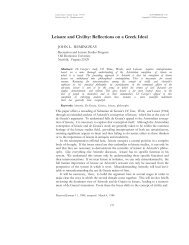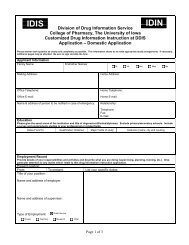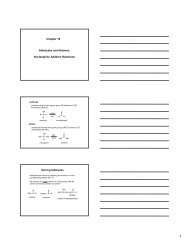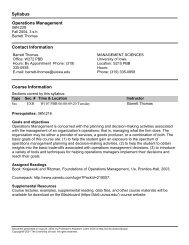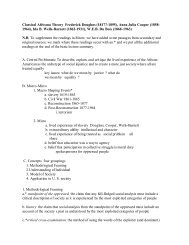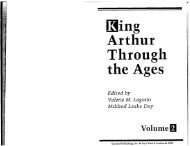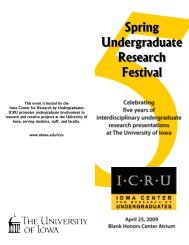Twenty-Five Years of Batson: An Introduction to ... - University of Iowa
Twenty-Five Years of Batson: An Introduction to ... - University of Iowa
Twenty-Five Years of Batson: An Introduction to ... - University of Iowa
Create successful ePaper yourself
Turn your PDF publications into a flip-book with our unique Google optimized e-Paper software.
2012] TWENTY-FIVE YEARS OF BATSON 1405<br />
One overarching question was whether the Court’s incursion was the<br />
first step in a process leading <strong>to</strong> the abolition <strong>of</strong> peremp<strong>to</strong>ry challenges. The<br />
contention that peremp<strong>to</strong>ries should be eliminated rests on the premise that<br />
conscious and unconscious race discrimination are realities that cannot be<br />
combated by mere regulation <strong>of</strong> peremp<strong>to</strong>ry challenges and that the only<br />
way <strong>to</strong> effectively control unconstitutional use is abrogation. 95 The realities<br />
<strong>of</strong> discrimination and the fact that Swain’s approach was ineffectual were<br />
among the reasons for the <strong>Batson</strong> revolution, which many scholars have<br />
deemed woefully inadequate. 96 Nonetheless, it seems virtually certain that<br />
the Court will adhere <strong>to</strong> <strong>Batson</strong>’s more modest prescription and refuse <strong>to</strong><br />
perform the more radical surgery that some believe is essential. 97<br />
Other questions centered on the scope <strong>of</strong> <strong>Batson</strong>’s equal protection<br />
restrictions. Was <strong>Batson</strong> confined <strong>to</strong> race discrimination, as much <strong>of</strong> its<br />
language might suggest, 98 or might it also constrain other types <strong>of</strong><br />
peremp<strong>to</strong>ry challenge discrimination? 99 Whether the Constitution forbade<br />
strikes based on sex, religion, age, sexual orientation, or socio-economic<br />
status, for example, was unknown. 100<br />
<strong>An</strong>other question was whether a defendant could object <strong>to</strong> the removal<br />
<strong>of</strong> members <strong>of</strong> another race. <strong>Batson</strong>’s prima facie case required a showing<br />
that the prosecu<strong>to</strong>r removed jurors <strong>of</strong> the defendant’s race. 101 Moreover,<br />
<strong>Batson</strong> regulated peremp<strong>to</strong>ries exercised by the government. 102 The opinion<br />
contained no clear indications <strong>of</strong> whether there was any equal protection<br />
control over purposeful race discrimination by defendants.<br />
There were also “doctrinal” uncertainties in the wake <strong>of</strong> <strong>Batson</strong>. What<br />
was sufficient <strong>to</strong> establish an “inference” that would require the government<br />
<strong>to</strong> defend its peremp<strong>to</strong>ries? What showing by the government would suffice<br />
<strong>to</strong> rebut a prima facie case? The Court made clear that an explanation need<br />
not satisfy the “for cause” standard but did not specify the showing sufficient<br />
95. See <strong>Batson</strong> v. Kentucky, 476 U.S. 79, 103, 107–08 (1986) (Marshall, J., concurring); see<br />
also Morris B. H<strong>of</strong>fman, Peremp<strong>to</strong>ry Challenges Should Be Abolished: A Trial Judge’s Perspective, 64 U.<br />
CHI. L. REV. 809 (1997); Nancy S. Marder, Justice Stevens, the Peremp<strong>to</strong>ry Challenge, and the Jury, 74<br />
FORDHAM L. REV. 1683, 1715–17 (2006).<br />
96. See, e.g., Albert W. Alschuler, The Supreme Court and the Jury: Voir Dire, Peremp<strong>to</strong>ry<br />
Challenges, and the Review <strong>of</strong> Jury Verdicts, 56 U. CHI. L. REV. 153 (1989); Kenneth J. Melilli,<br />
<strong>Batson</strong> in Practice: What We Have Learned About <strong>Batson</strong> and Peremp<strong>to</strong>ry Challenges, 71 NOTRE DAME<br />
L. REV. 447, 505 (1996); Melynda J. Price, Performing Discretion or Performing Discrimination: Race,<br />
Ritual, and Peremp<strong>to</strong>ry Challenges in Capital Jury Selection, 15 MICH. J. RACE & L. 57 (2009).<br />
97. Among the Justices, there has been only isolated support for abolition. See Rice v.<br />
Collins, 546 U.S. 333, 342–44 (2006) (Breyer, J., concurring); Miller-El v. Dretke, 545 U.S.<br />
231, 273 (2005) (Breyer, J., concurring); <strong>Batson</strong>, 476 U.S. at 107–08 (Marshall, J., concurring).<br />
98. See <strong>Batson</strong>, 476 U.S. at 82, 86–88, 89, 93, 96.<br />
99. See id. at 123–24 (Burger, C.J., dissenting).<br />
100. See Powers v. Ohio, 499 U.S. 400, 429–30 (1991) (Scalia, J., dissenting).<br />
101. <strong>Batson</strong>, 476 U.S. at 96.<br />
102. Id.





